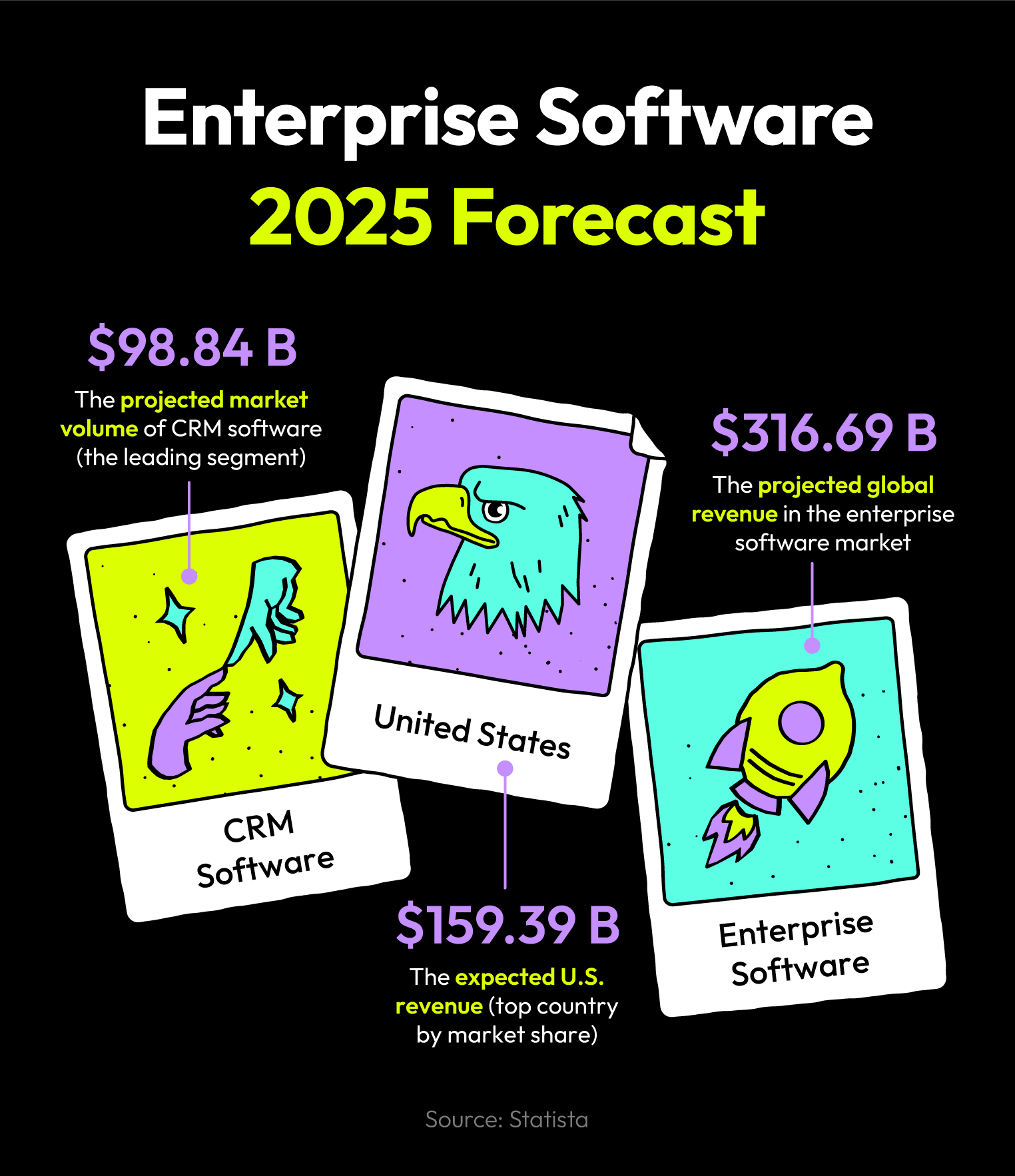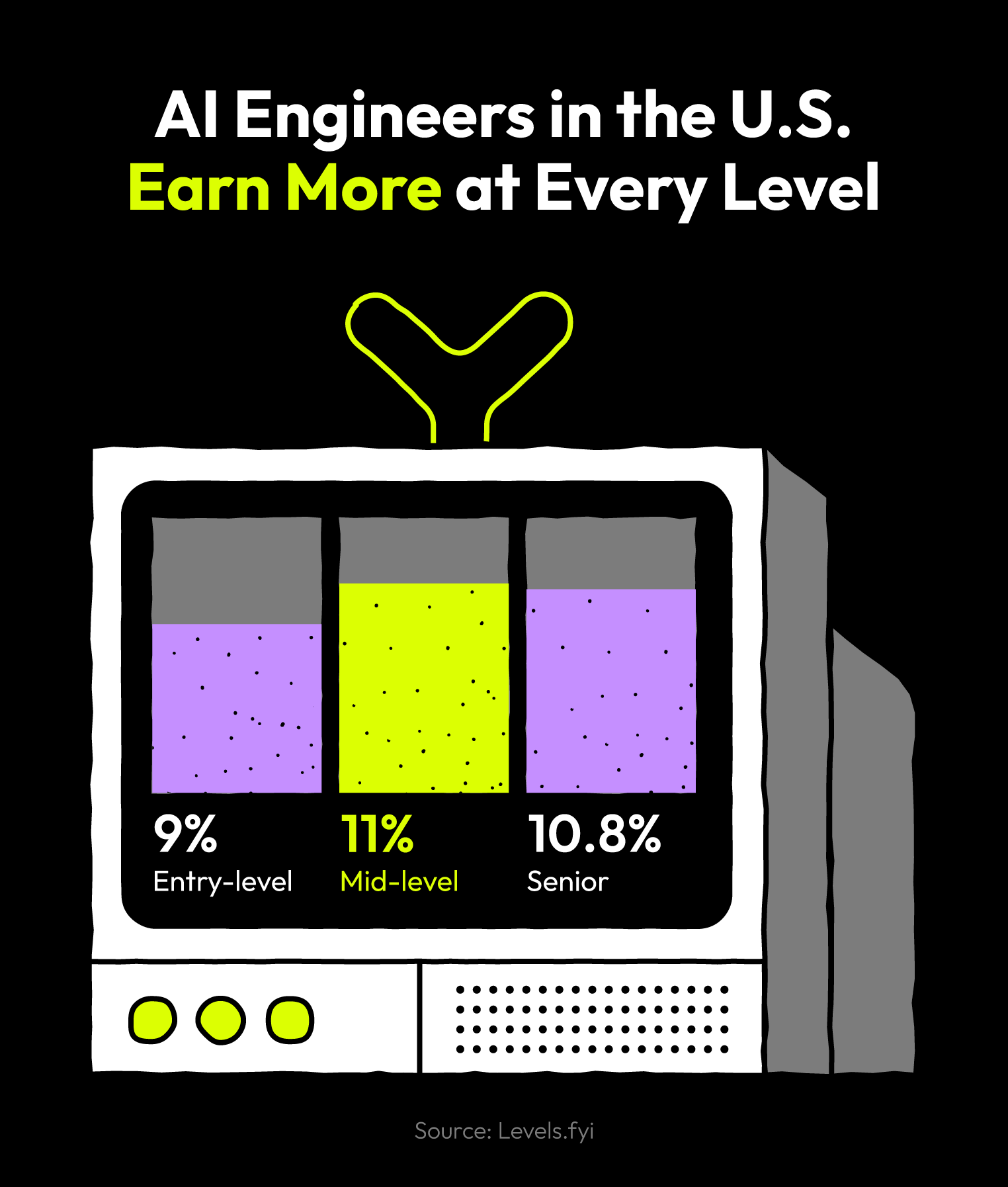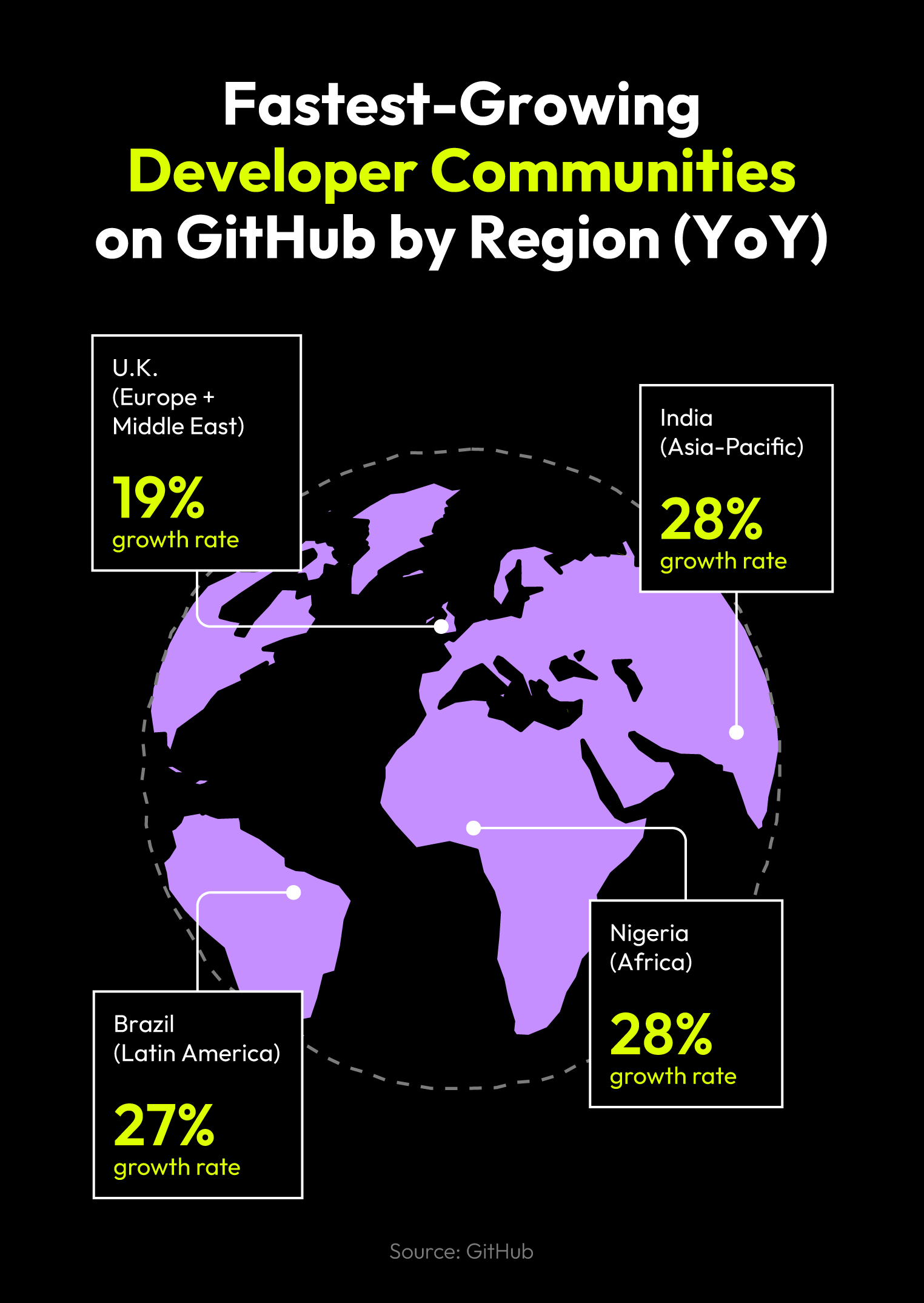Lemon.io Insight:
The demand for AI-related specializations in engineering grew significantly, from 2% in 2022 to 10% in 2024.
For tech companies, staying ahead in the software market landscape means more than just offering a competitive compensation package. It also means understanding the shifting software market trends shaping how and who you hire.
One of the most seismic shifts we’ve seen is the impact of AI. Major tech companies are doubling down on engineers who can harness AI tools effectively.
In this post, we’ll break down the key software market trends defining the industry today, from overall growth and revenue shifts to the languages developers prioritize, the hottest industries for hiring, the real impact of AI, and why location still matters, even in 2025.
Plus, we’ll dive into why hiring top-tier talent feels harder than ever, and what you can do about it.
Software Industry Size, Growth, and Revenue
The global software market is on a steep growth curve, and it’s not slowing down anytime soon.
North America continues to dominate, with the U.S. alone forecasted to generate more than $379 billion in 2025 thanks to its thriving tech ecosystem and leadership in cloud services and AI adoption.
Looking further ahead, the market is projected to grow at an annual rate of nearly 4%, reaching $902.7 billion by 2030. For startups and hiring managers, this rapid growth signals both opportunity and fierce competition, especially as demand surges for developers who can build, scale, and innovate within this booming landscape.

Programming Languages Businesses Prioritize
In 2025, a few programming languages stand out as the most widely used and in-demand across the software industry. According to Statista, these are the three most in-demand programming languages among recruiters in 2025:
- Python: Used in AI, machine learning, data science, and automation
- JavaScript: Foundational for web development and full-stack applications
- Java: Common in the enterprise software industry, backend systems, and Android development
These languages lead the way thanks to their versatility and strong developer ecosystems.
Python
In the 2024 GitHub Octoverse report, Python overtook JavaScript as the most used language on GitHub, ending JavaScript’s decade-long run at the top.
Unsurprisingly, it has surged in popularity due to its central role in AI, machine learning, and data science.
JavaScript
JavaScript fell to second place in GitHub’s Octoverse report but continues to be essential for web development, driving the functionality of dynamic user interfaces and full-stack applications.
Looking forward, Python and JavaScript are expected to remain at the top of the most in-demand languages.
Java
In the May 2025 TIOBE Index, Java ranks third among the most popular programming languages. Although it’s dropped in popularity, it’s still a mainstay on these lists because of its versatility when building apps and enterprise-level software.
Tech Stacks Businesses Prioritize
As demand for specialized developers continues to grow, particular tech stacks are becoming priorities for hiring teams.
Based on backend hiring data from Lemon.io, these are the top 10 tech stacks companies are hiring for in 2025:
- 20.5% of developer job listings call for a full tech stack using React, Node.js, and TypeScript.
- 10.7% of roles focus on frontend development with React and TypeScript.
- 8.1% of job postings seek full-stack developers working with React and Python.
- 7.2% of open positions are for AI-related roles, including machine learning and LLM development.
- 5.2% of backend developer roles prioritize experience with Python.
- 4.9% of mobile developer listings request skills in React Native.
- 3.9% of roles are in DevOps or Site Reliability Engineering (SRE).
- 2.9% of full-stack listings seek developers with experience in React and Ruby.
- 2.9% of mobile job postings call for development with Flutter.
- 2.6% of full-stack developer roles combine React, Python, and Node.js in their required tech stack.

Industries With the Most Demand for Developer Talent
Demand for software developers remains strong across nearly every sector and is expected to continue growing.
The U.S. Bureau of Labor Statistics shows that the employment of software developers, quality assurance analysts, and testers is expected to grow by 17% from 2023 to 2030—a significantly higher rate than the average for all occupations.
Lemon.io backend hiring data reveals these industries are driving current client projects for developers:
- AI projects make up 10% of all active developer assignments.
- SaaS projects represent 5% of current developer work.
- Healthcare projects account for 3% of developer engagements.
- Healthtech projects make up 3.32% of ongoing assignments.
During client calls, these industries were mentioned most often according to Lemon.io data:
- Mobile apps were mentioned in 5% of client calls.
- Fintech came up in 4% of client conversations.
- E-commerce was referenced in 3% of calls.
- AI was mentioned in 3% of client discussions.
- Healthcare appeared in 2% of client conversations.
Roles related to artificial intelligence are seeing a sharp increase. AI-focused specializations, such as machine learning, data science, and AI engineering, grew from just 2% of developer roles in 2022 to 10% in 2024. As more organizations explore AI integration and automation, developers with skills in these areas will continue to be in high demand.
How AI Has Changed the Software Market
Artificial intelligence is reshaping software development, influencing both the nature of the work and the job market.
While the overall outlook for developers remains positive, job postings on sites like Indeed have dropped more than one-third from five years ago, according to Business Insider.
Some companies, like Salesforce, have even suggested they may not need to hire additional engineers due to AI’s productivity gains.
Upskilling Is Key to Staying Competitive
Entry-level roles are also shifting. Tasks like writing boilerplate code are increasingly handled by AI, pushing junior developers into roles focused on supervising AI.
A Gartner survey found that 80% of engineering teams will need to upskill by 2027, and over half of software leaders cited AI/ML engineers as the most in-demand role for 2024. Unsurprisingly, AI developers have some of the highest-paying software engineering jobs.
Fewer Big Tech Companies Hiring Recent Grads
According to SignalFire’s State of Talent Report, new grads are facing a tighter job market. In Big Tech, they make up just 7% of hires. This is down over 50% from pre-pandemic levels, with startups hiring even fewer new grads.
Instead, Big Tech companies are focusing on mid- and senior-level engineers with more experience, particularly in machine learning and data science.
AI in the Screening Process
AI is also changing hiring practices. Nearly 9 in 10 companies now use AI in the initial screening process, though according to Insight Global, 93% of hiring managers see the importance of including humans in the hiring process.
While AI-powered hiring can efficiently filter large applicant pools, it often misses the nuance that human evaluators catch.
Quality Vetting Is Fundamental to Finding the Right Candidate
AI may be able to screen for technical skills, which are important when hiring developers, but this isn’t the only thing that makes a developer a good candidate.
There’s a gap that needs to be filled by a human recruiter who can evaluate candidates on critical traits like creativity, communication, and business sense.
Understanding team dynamics and problem-solving approach is something algorithms still struggle to assess.

Geographic Shifts in Software Development
As demand for technical talent grows, more startups are turning to offshore and nearshore developers to scale efficiently.
Verified Market Research shows that offshore development can reduce costs by up to 60% compared to on-site builds. As a result, the global offshore development market is projected to triple, reaching nearly $390 billion by 2033.
Nearshore software development offers a compelling middle ground. It has many of the same benefits as offshoring, while improving real-time collaboration thanks to shared time zones and cultural alignment.
Rapid growth of developer communities outside the U.S. is fueling this shift. India is expected to surpass the U.S. as the largest developer population on GitHub by 2028, while countries like Brazil, Nigeria, and the Philippines are also experiencing fast growth.
Working with offshore developers can be a cost-effective solution, but it comes with its own set of challenges. Language barriers and cultural differences can make communication difficult, while differing time zones may lead to delays and slower project turnaround.
As a result, human vetting will be key in the next generation of hiring software developers, especially when it comes to offshore and nearshore candidates.

Difficulty Recruiting Skilled Developers
Hiring skilled developers remains a major challenge, especially when it comes to recruiting AI/machine learning specialists. 22% of recruiters say they think they’ll struggle to for this role, according to CodinGame’s State of Tech Hiring 2025.
While the global talent pool has expanded thanks to practices like offshoring and nearshoring, that growth brings new layers of complexity.
Startups now have access to skilled engineers in a global market, but hiring across borders also means navigating unfamiliar legal systems and tax structures. For those deciding between hiring models, understanding the freelance vs. in-house options can help clarify the best approach for your project.
As a result, many companies are turning to developer hiring platforms that promise fast, scalable recruiting, often powered by AI. Unfortunately, these platforms often fall short. Many companies end up with developers who lack the depth of expertise they claim, leading to missed deadlines and costly delays.
To avoid these setbacks, it’s critical to go beyond automated tools and focus on human vetting. A thorough vetting process goes beyond looking at surface-level skills, and though it’s a slower, more deliberate process, it results in stronger matches and fewer disappointments.
AI has secured its place in the top 5 most popular programming languages right now. On top of that, it holds the #1 spot among the industries of our all-time clients. The demand is real—and growing.
Hire Software Developers Through Lemon.io
From shifting geographies to the rise of AI and evolving developer roles, the software market is constantly changing. This makes it harder to keep up with software market trends and even harder to know how to hire a software developer who’s the right fit for your team.
When you’re ready to move forward, Lemon.io connects you with rigorously vetted developers who bring both technical skills and real-world problem-solving to the table. Hire a software developer and build with confidence.










